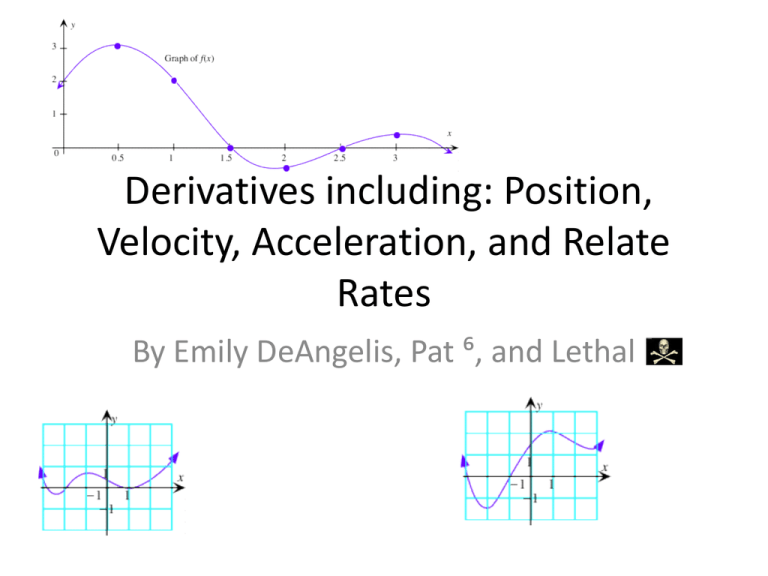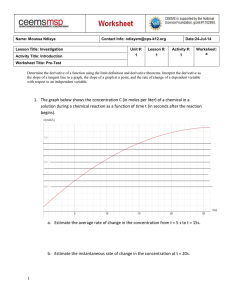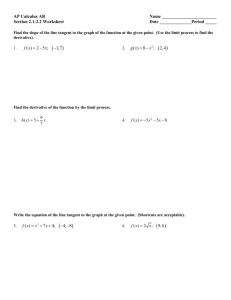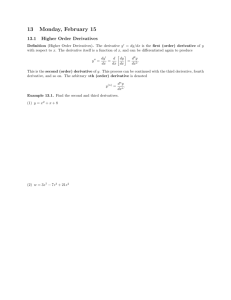Position, Velocity, Acceleration, and Relate Rates
advertisement

Derivatives including: Position, Velocity, Acceleration, and Relate Rates By Emily DeAngelis, Pat ⁶, and Lethal Derivatives of Trig Trig Derivative Example Prove the derivative of tanx. tan x sinx cosx cos x(cos x) sin x( sin x) cos 2 x cos 2 x sin 2 x cos 2 x 1 cos 2 x sec 2 x Derivatives • We have already been taught the definition of a derivative: f ( x h) f ( x) h • We also know how derivatives relate to the equation of lines – Ex. Average rate of change can be found by calculating the slope of a secant line – Instantaneous rate of change can be found by calculating the slope of a tangent line Derivatives of Exponential Functions Ex. Rules or Methods • Several methods/rules – Constant rule: – Sum rule: – Product Rule: – Quotient Rule: – Chain Rule: Examples • Constant Rule: • Sum Rule: • Product Rule: Examples • Quotient Rule: – • Chain Rule )= Derivatives with exponents and logarithms Ex. = What can we use a derivative for! • We know that dy/dx can be used to find: – Instantaneous rate of change – Slope of tangent line/curve • Average rate of change – D=rt, (distance= rate * time) therefore: • R=d/t – this is the average speed – Another word for speed is velocity! • Velocity is speed with a directional component How does velocity relate to speed and acceleration? • Velocity acts as a derivative of position – Speed is the absolute value of velocity • Speed=IvelocityI • If your position is changed then there exists some type of speed of velocity – S’(t)=v(t) • Same thing with acceleration- If you change your velocity there exists some type of acceleration – V’(t)=a(t) • S’’(t)=v’(t)=a(t) Example A mistress moves in a straight line according to this equation of motion: s(t) = 10t ² − 4t + 8, where t is measured in seconds and s in meters. a) What is its position at the end of 5 sec? s(5) = 10· 5² − 4· 5 + 8 = 238 m. b) What is the equation for its velocity v at any time t ? v(t) = ds/dt = 20t − 4. c) What is its velocity v at at the end of 5 seconds? v(5) = 20· 5 − 4 = 96 m/sec. d) What is the equation for its acceleration a at any time t ? a(t) = d²s/dt² = dv/dt = 20. e) What is its acceleration at the end of 5 seconds? a(5) = 20 m/sec². Formulas for Position of a Projectile • Another term for position is height • Height of the projectile is defined by the formula: – h(t)= -½g t^2+vOt+sO • • • • g is acceleration due to gravity (32 ft/sec^s or 9.8 m/s) vo is the initial velocity so is the initial position t is time Example • A ginger launches a ball vertically from the top of a building 40m high with a velocity of 55m/s – Find the equation representing position, velocity, and acceleration – What is the maximum height of the ball? – When will the ball reach the ground? – When will the ball reach its original position – How long is the ball in the air? – How far does the ball travel? What’s Rectilinear Motion? • It is motion on a straight line, only focusing on two directions: along the direction of motion, and opposite the direction of motion – To illustrate this, imagine a gypsy riding her stolen bike east. Her velocity is east, as well as her acceleration. As she applies the brakes, the direction of acceleration turns to west. As she slows down, the acceleration of the bike is westward Terms You Need to Know • • • • • • t- time s(t)- position v(t)- velocity a(t)- acceleration s1(t ) s0(t ) Average Velocityt1 t 2 Instantaneous Velocity= derivative Example • A sinful Pharaoh’s position is given by the equation: 2 3 3 2 – s(t)= t -6t +16t • What’s the hobo’s velocity at time t? – v(t)= 2t 2 -12t+16 • What’s the hobo’s velocity at t=3 and t=5? – v(3)= -2 v(5)=6 • When is the hobo resting? 2 – v(t)=0 2t -12t+16(t-4)(t-2)t=4sec & 2sec • When is the hobo running forward? – [0,2)U(4, ) Implicit Differentiation • • Implicit differentiation Consider the following: – x² + y² = r² • • • • This is the equation of a circle with radius r. Let us calculate dy dx To do that, we could solve for y and then take the derivative. But rather than do that, we will take the derivative of each term. We will assume that y is a function of x, and we will apply the chain rule. Then we will solve for dy dx d dx x² + d dx y² = d dx r² 2x + 2y dy dx = 0 dy dx = − x y This is called implicit differentiation. y is implicitly a function of x. The result generally contains both x and y. Example • In Optimus Prime’s circle, • x² + y² = 25, – a) what is the y-coordinate when x = −3? • y = 4 or −4. For,(−3)² + (±4)² = 5² – b) What is the slope of the tangent to the circle at (−3, 4)? • 3 4 . For, the derivative is − x y – c) What is the slope of the tangent to the circle at (−3, −4)? • −3 4 The Derivative of an Inverse Function • When we have a function y = f(x) -- for example y=x2 • then we can often solve for x. In this case, x= y • On exchanging the variables, we have y= x • y= x is called the inverse function of y = x² Inverse Function con’t • f(x) = x² g(x) = And let us call f the direct function and g the inverse function. The formal relationship between f and g is the following: » f( g(x)) = g( f(x)) = x. • Here are other pairs of direct and inverse functions: • f(x) = sin x g(x) = arcsin x f(x) = ax g(x) = logax f(x) = x3 g(x) = Now, when we know the derivative of the direct function f, then from it we can determine the derivative of g. • Thus, let g(x) be the inverse of f(x). Then f(g(x) )= x. • Now take the derivative with respect to x: • This implies that: Example • Let f(x) = x², and g(x)= x Then f( g) = g² • This means that: Related Rates • Application of implicate differentiation • For related rates problems, we are concerned with how quickly things are changing with respect to time Steps to solving a Related Rates 1. Make a sketch and label the given information. 2. Determine what you are asked to find and write down an equation that relates the variables. 3. Take a derivative of the equation with respect to time. 4. Substitute in given values and evaluate. Make sure to not plug in the values before taking a derivative of the equation. 5. Solve for the unknown value. Related Rates Example 1 An 10 foot long ladder is leaning against a wall. The top of the ladder is sliding down the wall at the rate of 2 feet per second. How fast is the bottom of the ladder moving along the ground at the point in time when the bottom of the ladder is 6 feet from the wall? 10 ft 8 ft 6 ft Related Rates Example 1 (Continued) 10 ft 8 ft 6 ft Related Rates Example 2 A first born child has a tank in the shape of a cone is leaking water at a constant rate of 2 ft3/hour. The base radius of the tank is 5 ft and the height of the tank is 14 ft. At what rate is the depth of the water in the tank changing when the depth of the water is 6 ft? Related Rates Example 2 (Continued) dh 0.13864 ft 3 / hour dt






